
An echinoderm is any deuterostomal animal of the phylum Echinodermata, which includes starfish, brittle stars, sea urchins, sand dollars and sea cucumbers, as well as the sessile sea lilies or "stone lilies". While bilaterally symmetrical as larvae, as adults echinoderms are recognisable by their usually five-pointed radial symmetry, and are found on the sea bed at every ocean depth from the intertidal zone to the abyssal zone. The phylum contains about 7,600 living species, making it the second-largest group of deuterostomes after the chordates, as well as the largest marine-only phylum. The first definitive echinoderms appeared near the start of the Cambrian.

Starfish or sea stars are star-shaped echinoderms belonging to the class Asteroidea. Common usage frequently finds these names being also applied to ophiuroids, which are correctly referred to as brittle stars or basket stars. Starfish are also known as asteroids due to being in the class Asteroidea. About 1,900 species of starfish live on the seabed in all the world's oceans, from warm, tropical zones to frigid, polar regions. They are found from the intertidal zone down to abyssal depths, at 6,000 m (20,000 ft) below the surface.

Solaster paxillatus, the orange sun star, is a species of starfish found at varying depths in the northern Pacific Ocean. It is a natural predator of the starfish Asterias amurensis.
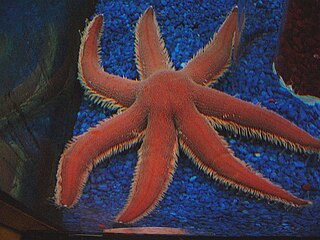
Luidia ciliaris, the seven-armed sea star, is a species of sea star (starfish) in the family Luidiidae. It is found in the eastern Atlantic Ocean and the Mediterranean Sea.
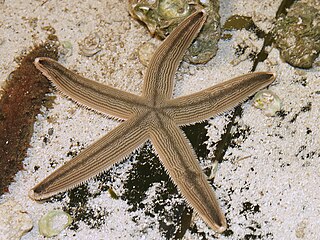
Luidia clathrata is a tropical species of starfish in the family Luidiidae. It is variously known as the slender-armed starfish, the gray sea star, or the lined sea star. It is found in the western Atlantic Ocean.
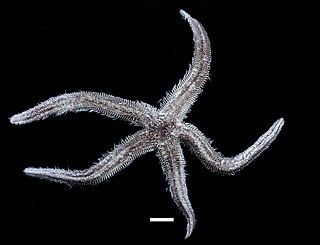
Luidia superba is a tropical species of starfish in the family Luidiidae. A single specimen was found off the Pacific coast of Colombia in 1888; the species has since been found in the Galapagos Islands. It is endemic to this area and has not been recorded elsewhere.

Leptasterias hexactis is a species of starfish in the family Asteriidae, commonly known as the six-rayed star. It is found in the intertidal zone of the western seaboard of the United States. It is a predator and is unusual among starfish in that it broods its eggs and young.
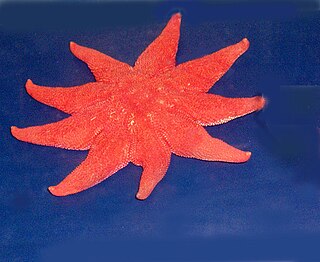
The purple sunstar, northern sunstar, or smooth sun star, Solaster endeca, is a species of starfish in the family Solasteridae.

Evasterias troschelii is a species of starfish in the family Asteriidae. Its common names include the mottled star, false ochre sea star and Troschel's true star. It is found in Kamchatka and the north western coast of North America.

Luidia senegalensis, the nine-armed sea star, is a tropical species of starfish in the family Luidiidae found in the western Atlantic Ocean.
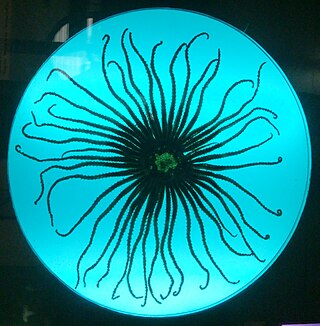
Labidiaster annulatus, the Antarctic sun starfish or wolftrap starfish is a species of starfish in the family Heliasteridae. It is found in the cold waters around Antarctica and has a large number of slender, flexible rays.

Luidia foliolata, the sand star, is a species of starfish in the family Luidiidae found in the northeastern Pacific Ocean on sandy and muddy seabeds at depths to about 600 m (2,000 ft).

The spiny sand seastar is a species of starfish in the family Luidiidae. It is found in shallow parts of the China Sea and in the vicinity of the Korean archipelago. The tissues of this starfish have been found to contain several secondary metabolites with medicinal potential.
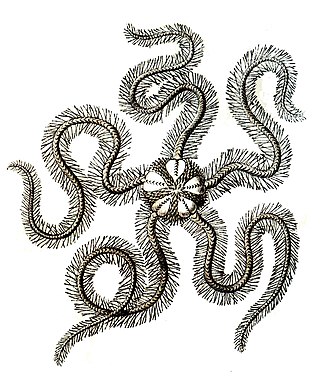
Ossicles are small calcareous elements embedded in the dermis of the body wall of echinoderms. They form part of the endoskeleton and provide rigidity and protection. They are found in different forms and arrangements in sea urchins, starfish, brittle stars, sea cucumbers, and crinoids. The ossicles and spines are the only parts of the animal likely to be fossilized after an echinoderm dies.
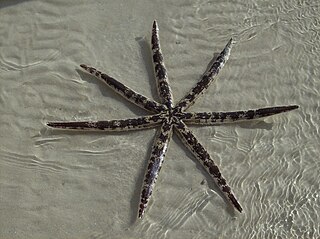
Luidia maculata is a species of starfish in the family Luidiidae in the order Paxillosida. It is native to the Indo-Pacific region. It is commonly known as the eight-armed sea star because, although the number of arms varies from five to nine, eight arms seems to be the most common.

Ophiactis savignyi is a species of brittle star in the family Ophiactidae, commonly known as Savigny's brittle star or the little brittle star. It occurs in the tropical and subtropical parts of all the world's oceans and is thought to be the brittle star with the most widespread distribution. It was first described by the German zoologists Johannes Peter Müller and Franz Hermann Troschel in 1842. The specific name honours the French zoologist Marie Jules César Savigny.

Neoferdina cumingi, also known as Cuming's sea star, is a species of starfish in the family Goniasteridae. It is native to the tropical Indo-Pacific region.

Tetrapygus is a genus of sea urchins in the family Arbaciidae. It is a monotypic genus and the only species is Tetrapygus niger which was first described by the Chilean naturalist Juan Ignacio Molina in 1782. It is found in the southeastern Pacific Ocean on the coasts of South America.

Echinaster callosus, the warty sea star or the banded bubble star, is a species of starfish found in shallow parts of the western Indo-Pacific region. The disc and five slender arms are covered with white, pink, red or violet warts, often forming transverse bands of colour on the arms.

Coscinasterias muricata is a species of starfish in the family Asteriidae. It is a large 11-armed starfish and occurs in shallow waters in the temperate western Indo-Pacific region.




















